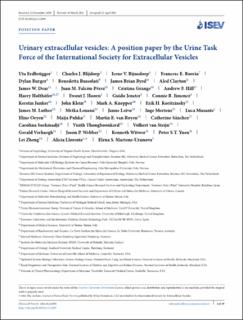| dc.contributor.author | Llorente, Alicia | |
| dc.contributor.author | Erdbrügger, Uta | |
| dc.contributor.author | Blijdorp, Charles J | |
| dc.contributor.author | Martens-Uzunova, Elena S. | |
| dc.date.accessioned | 2022-02-25T08:22:32Z | |
| dc.date.available | 2022-02-25T08:22:32Z | |
| dc.date.created | 2022-01-16T14:09:04Z | |
| dc.date.issued | 2021-05-21 | |
| dc.identifier.issn | 2001-3078 | |
| dc.identifier.uri | https://hdl.handle.net/11250/2981365 | |
| dc.description.abstract | Urine is commonly used for clinical diagnosis and biomedical research. The discovery of extracellular vesicles (EV) in urine opened a new fast-growing scientific field. In the last decade urinary extracellular vesicles (uEVs) were shown to mirror molecular processes as well as physiological and pathological conditions in kidney, urothelial and prostate tissue. Therefore, several methods to isolate and characterize uEVs have been developed. However, methodological aspects of EV separation and analysis, including normalization of results, need further optimization and standardization to foster scientific advances in uEV research and a subsequent successful translation into clinical practice. This position paper is written by the Urine Task Force of the Rigor and Standardization Subcommittee of ISEV consisting of nephrologists, urologists, cardiologists and biologists with active experience in uEV research. Our aim is to present the state of the art and identify challenges and gaps in current uEV-based analyses for clinical applications. Finally, recommendations for improved rigor, reproducibility and interoperability in uEV research are provided in order to facilitate advances in the field. | en_US |
| dc.description.sponsorship | ESM-U, CG, GV, GJ, IVB, MvR, and VvS, are members of the “IMMPROVE” consortium (Innovative Measurements and Markers for Prostate Cancer Diagnosis and Prognosis using Extracellular Vesicles), which is sponsored by an Alpe d'HuZes grant of the Dutch Cancer Society (grant #EMCR2015-8022). AL is supported by Norges Forskningsråd, Kreftforeningen and Helse Sør-Øst RHF (NO). UE is supported by the NIH, National Heart, Lung, and Blood Institute, Award number K23-HL-126101. CJB and EJH are supported by the Dutch Kidney Foundation (Nierstichting), Award number: CP18.05. | en_US |
| dc.language.iso | eng | en_US |
| dc.publisher | Wiley Open Access | en_US |
| dc.relation.ispartofseries | Journal of Extracellular Vesicles;Volume 10, Issue 7. May 2021 - e12093 | |
| dc.rights | Navngivelse 4.0 Internasjonal | * |
| dc.rights.uri | http://creativecommons.org/licenses/by/4.0/deed.no | * |
| dc.subject | Biobanks | en_US |
| dc.subject | Biomarkers | en_US |
| dc.subject | Bladders | en_US |
| dc.subject | Extracellular vesicles | en_US |
| dc.subject | Kidneys | en_US |
| dc.subject | Prostate | en_US |
| dc.subject | Urine | en_US |
| dc.title | Urinary extracellular vesicles: A position paper by the Urine Task Force of the International Society for Extracellular Vesicles | en_US |
| dc.type | Peer reviewed | en_US |
| dc.type | Journal article | en_US |
| dc.description.version | publishedVersion | en_US |
| dc.rights.holder | © 2021 The Authors | en_US |
| cristin.ispublished | true | |
| cristin.fulltext | original | |
| cristin.qualitycode | 1 | |
| dc.identifier.doi | https://doi.org/10.1002/jev2.12093 | |
| dc.identifier.cristin | 1981955 | |
| dc.source.journal | Journal of Extracellular Vesicles | en_US |
| dc.source.volume | 10 | en_US |
| dc.source.issue | 7 | en_US |
| dc.source.pagenumber | e12093 | en_US |

